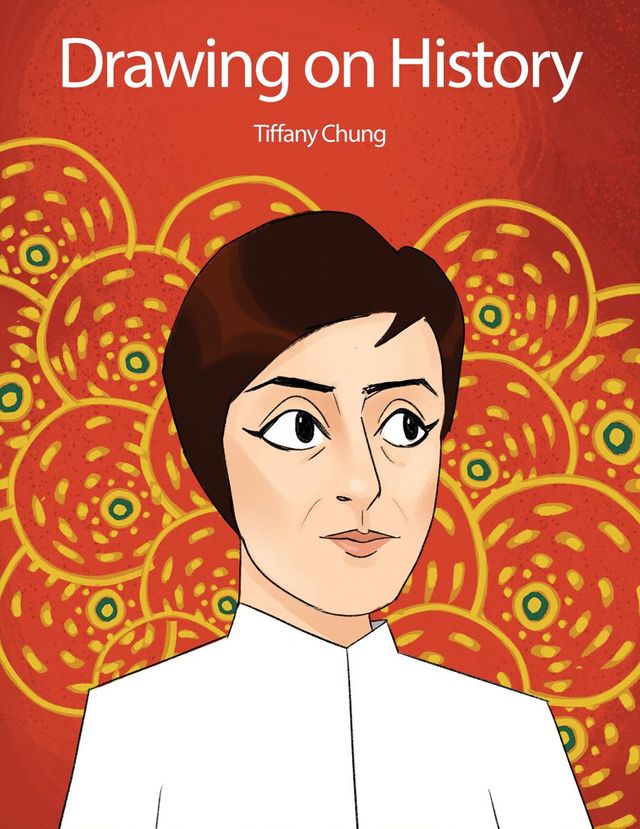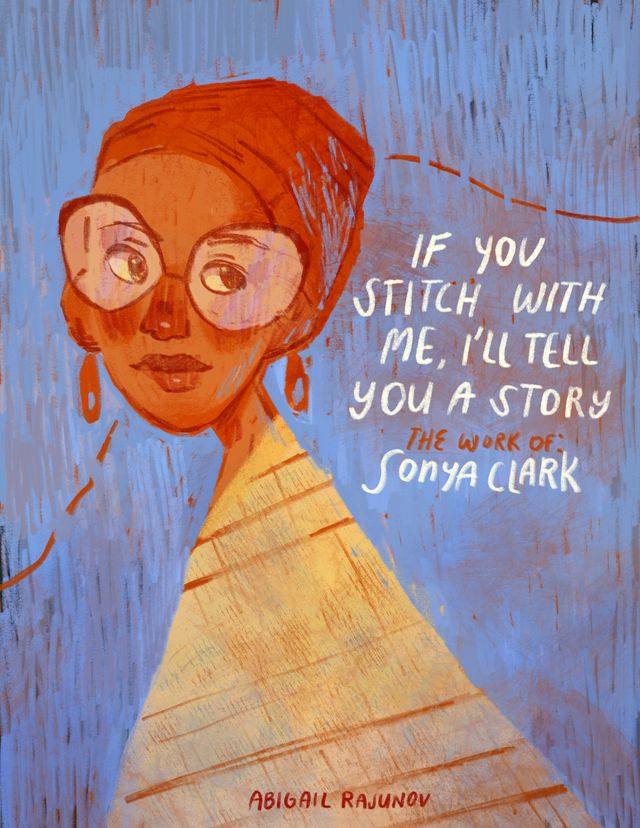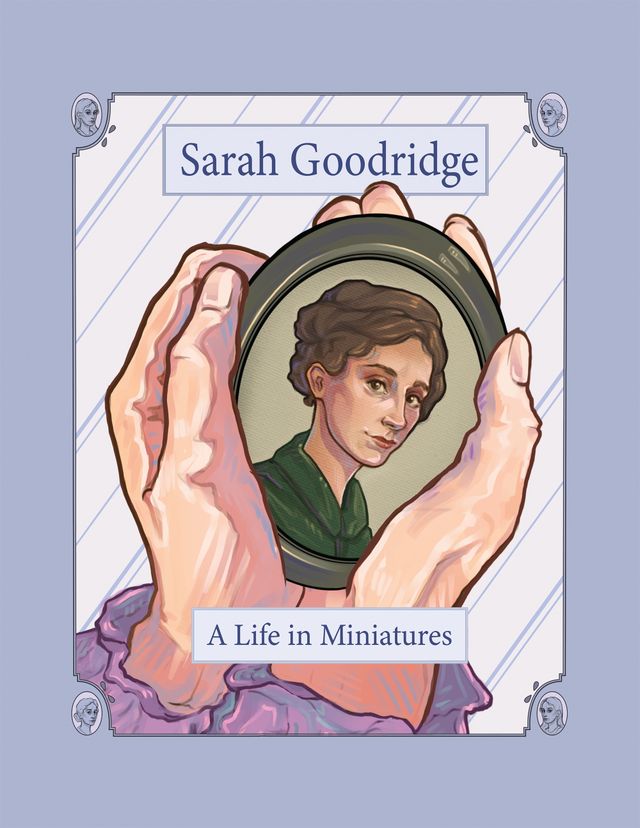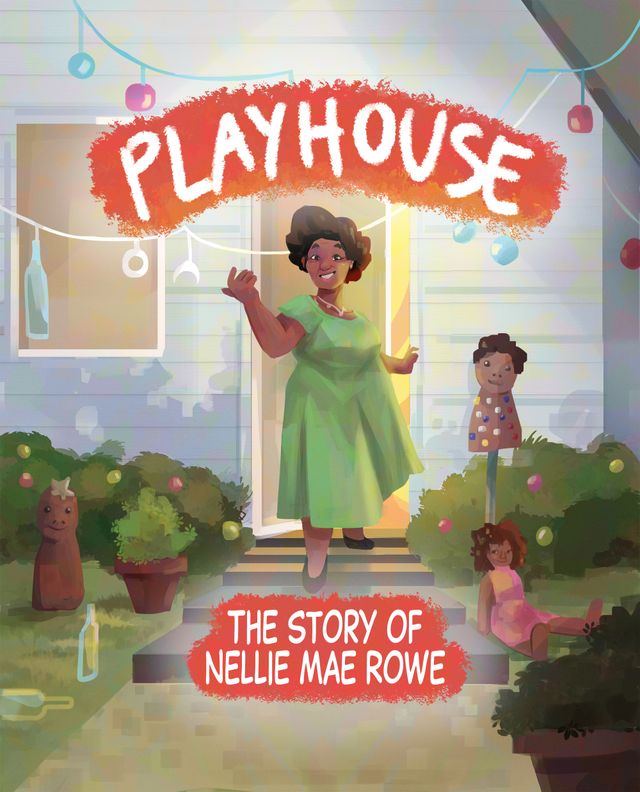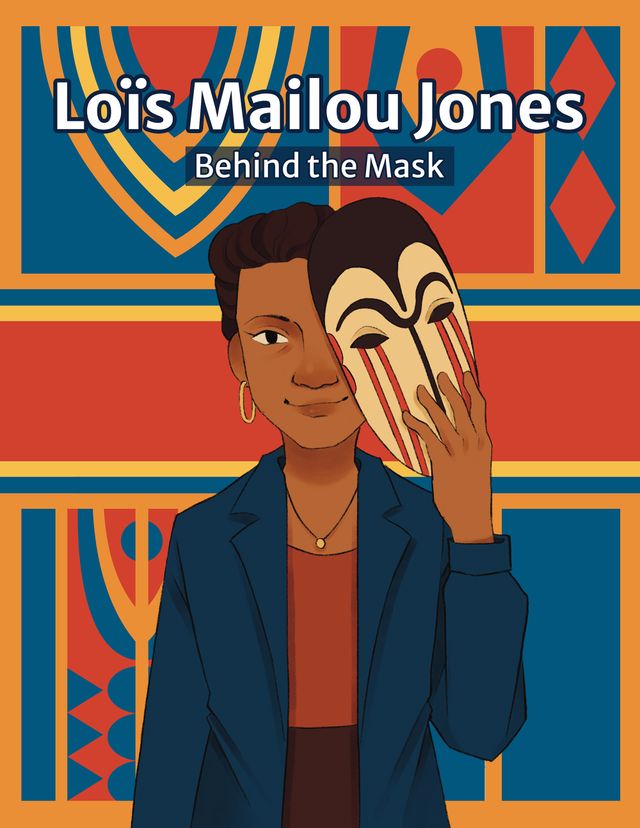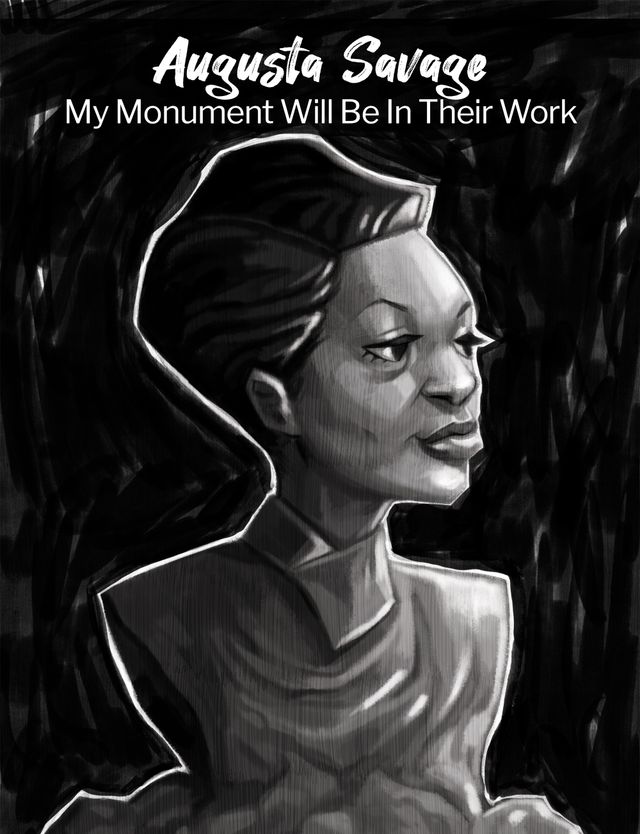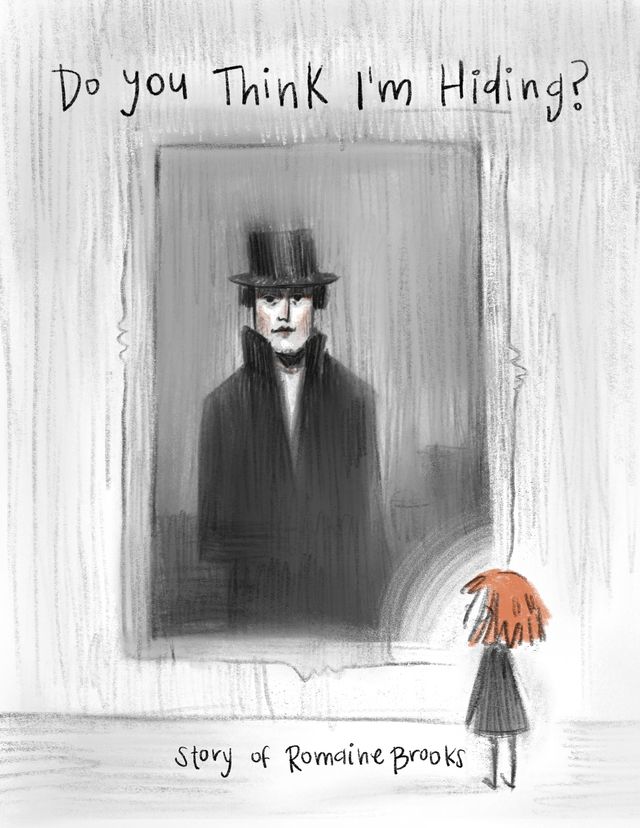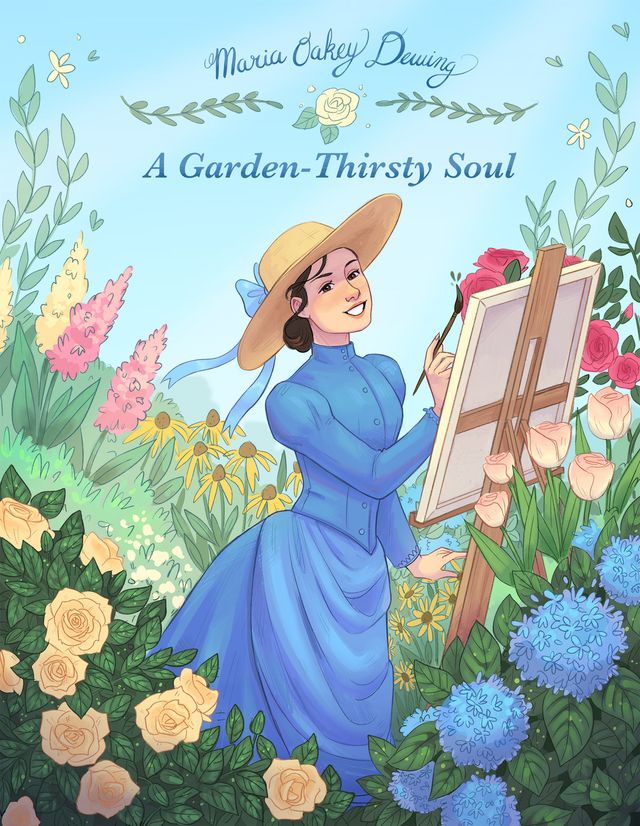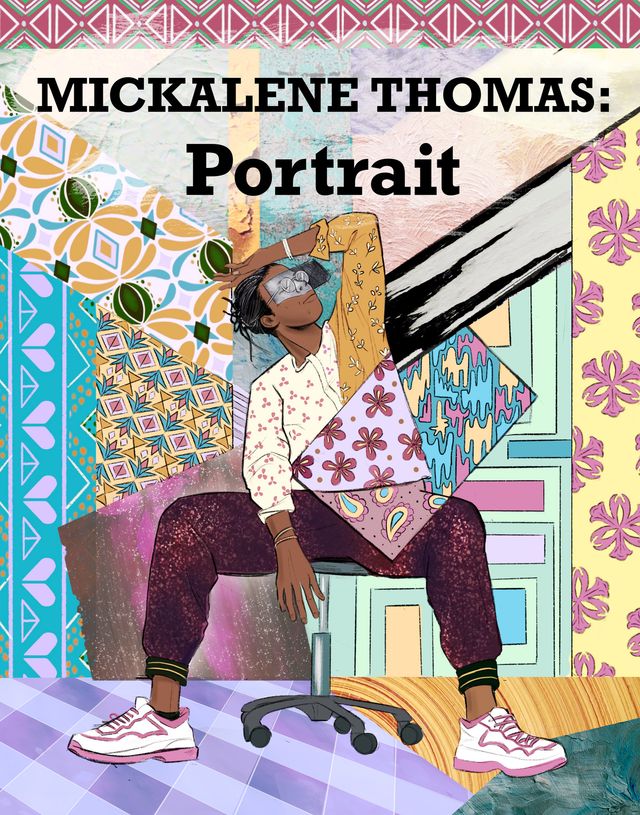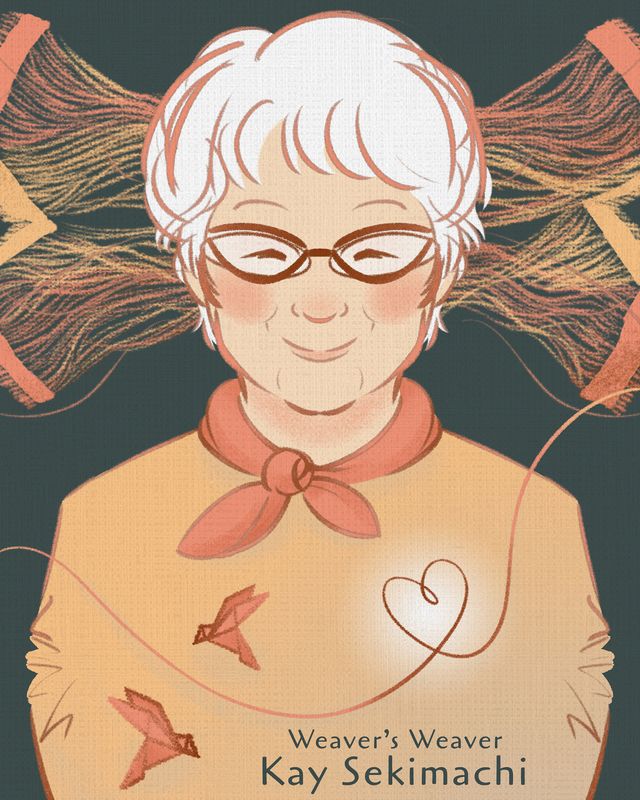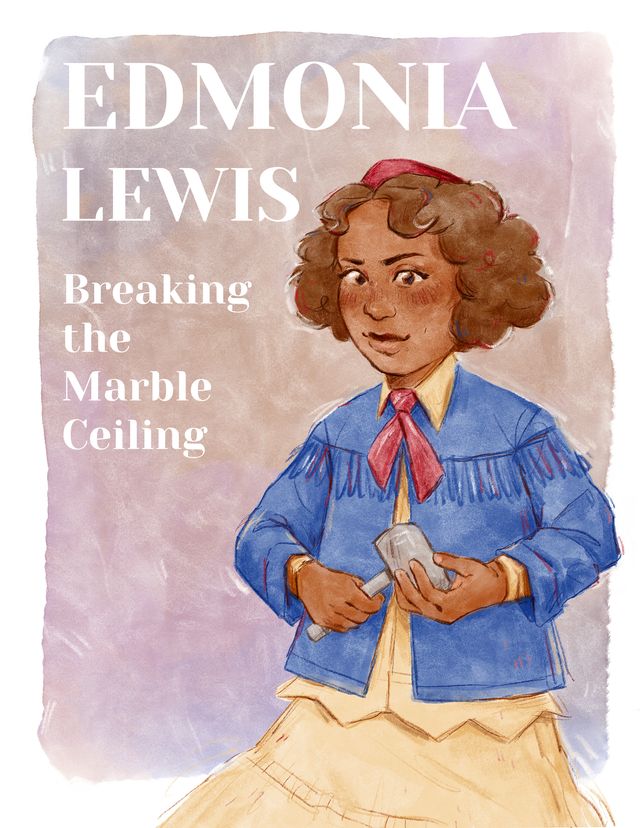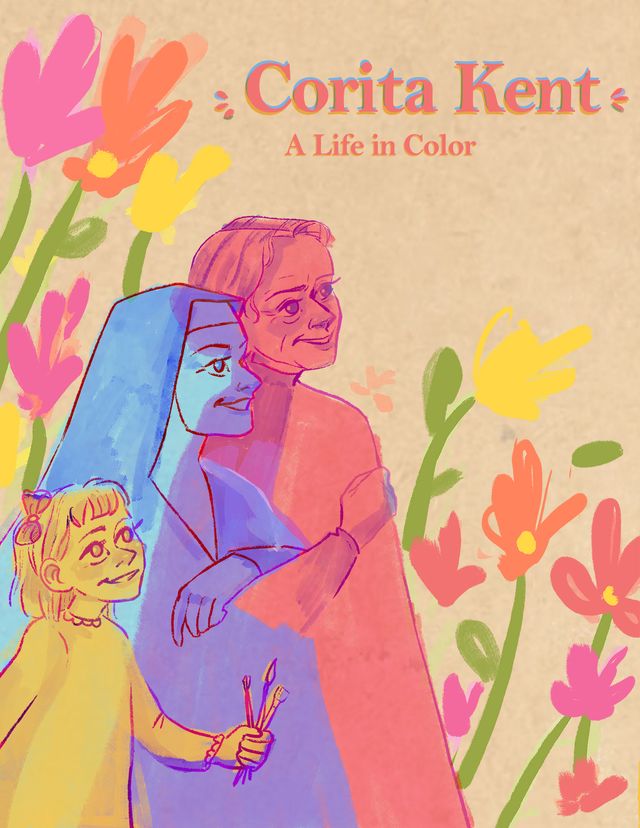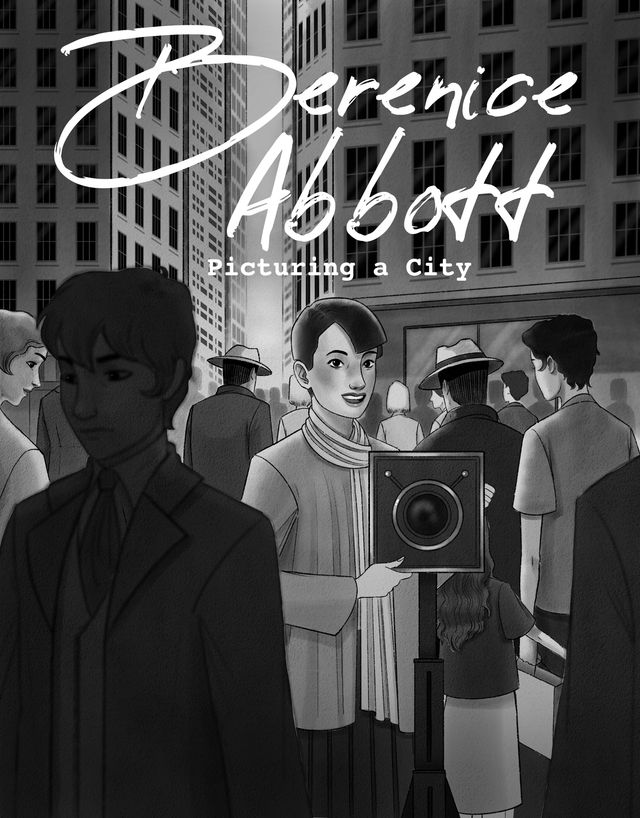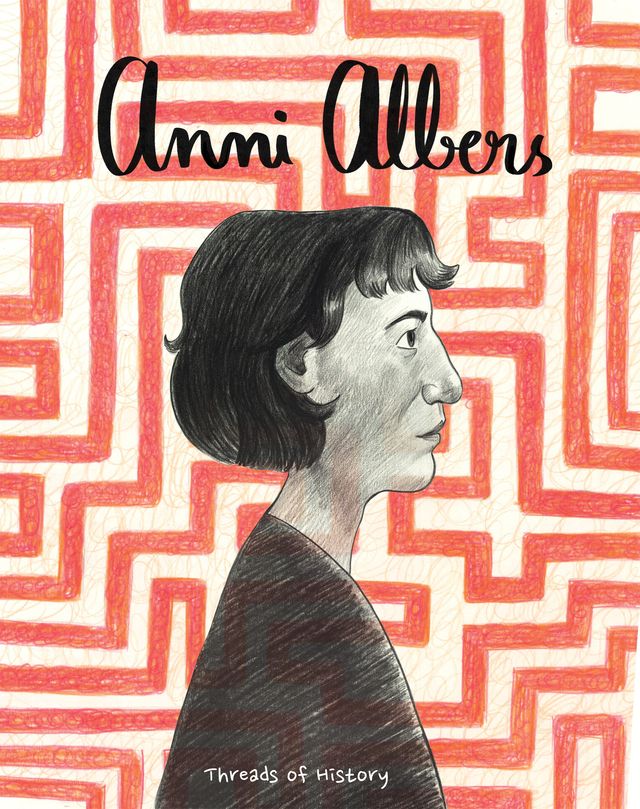An Overview
Jaune Quick-To-See Smith was born on the Flathead Indian Reservation in western Montana in 1940. As a child, she escaped her hard world through books and the drawings her father made for her. Now, she uses her art to powerfully express her beliefs.
This comic is part of a series Drawn to Art: Tales of Inspiring Women Artists that illuminates the stories of women artists in the collection of the Smithsonian American Art Museum. Inspired by graphic novels, these short takes on artists’ lives were each drawn by a student-illustrator from the Ringling College of Art and Design.
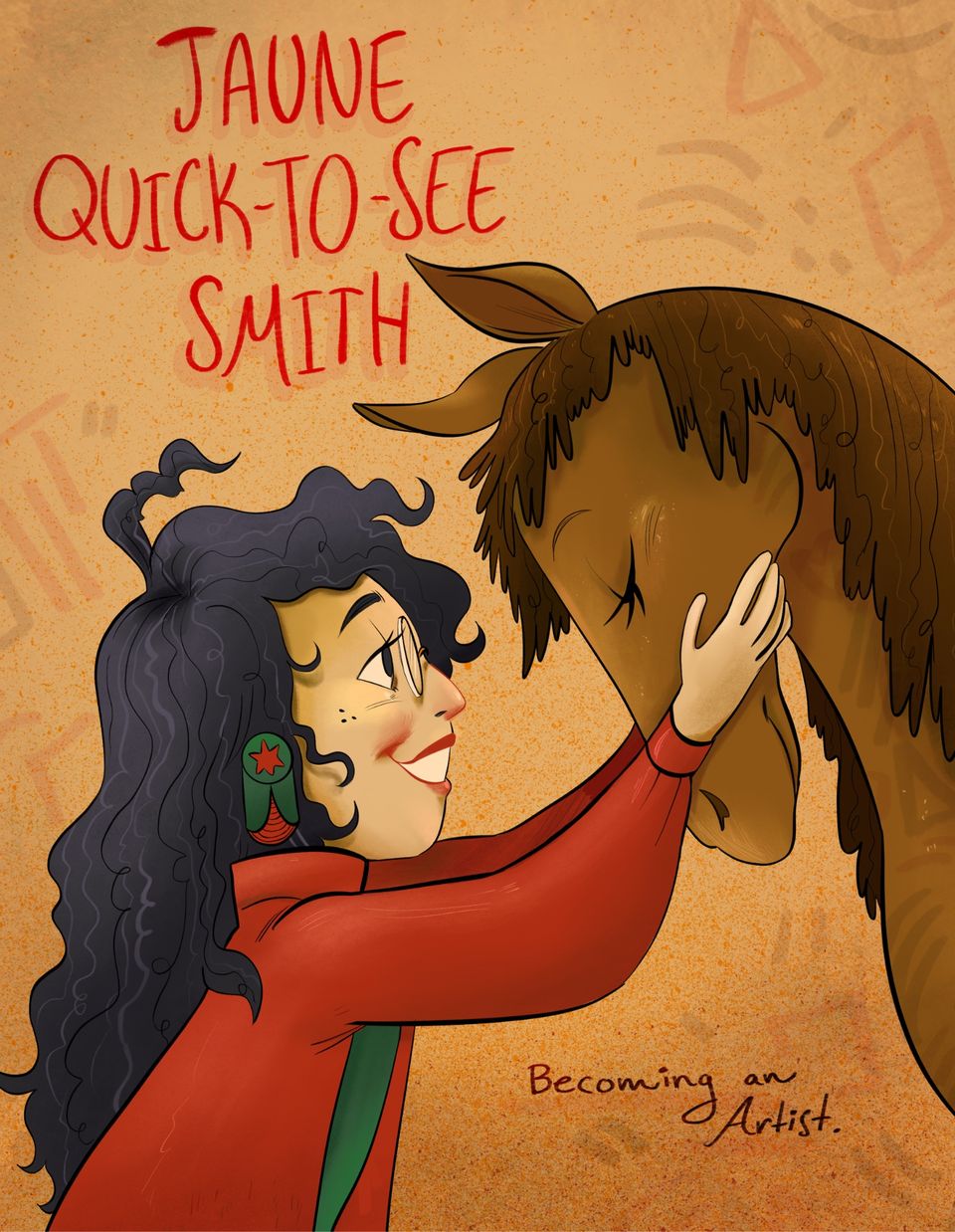
Jaune Quick-to-See Smith stands on the left, with her arms reaching out to a brown horse in front of her. Her black, curly hair extends to the middle of her back, with a large curl at the top. Her red cheeks and lipstick accentuate her bright smile. She’s wearing a sizable oval earring, green with a red 6-pointed star at the top and red beads at the bottom. The large horse smiles sweetly with its eyes closed, accepting Jaune’s gentle caress. Above them, text reads “Jaune Quick-To-See Smith'' in bold red. Below them to the right the title text reads: “Becoming an Artist.”

The page is divided into three horizontal panels.
Panel 1:
Jaune in the center, writing at a table with her left hand. Her right-hand waves toward the reader. Her clothes resemble those from the cover: a red collared shirt with a green undershirt, her green and red oval-shaped earrings, and a pair of circle-framed glasses. Her hair is long, wavy, and brown, curly tendrils frame her face and float around her head. The top right corner of the panel is a simple map of the state of Montana with a small patch highlighted in orange. Text above her reads, “Jaune Quick-To-See Smith was born in 1940 on the Flathead Indian Reservation in western Montana of French-Cree, Shoshone, and Salish descent.” Surrounding Jaune are two speech bubbles that contain text that reads, “As early as I can remember, I wanted to be an artist.”
Panel 2:
At the top, a quote from Jaune reads: "My dad was a horse trader. My whole tribe is a trading tribe. As a little kid, I can remember living in these one-room cabins with two other families”. Below this text are four horses running against a green background with white splattering effect. The horse on the far left is light brown with a flowing medium brown mane, followed by a dark brown horse with a flowing dark brown mane. The horse in the center is creamy white with a golden-brown mane and brown spots on its haunches. The final horse is caramel brown with a flowing yellow mane; its front legs are leaping outside the panel. A separate text box in the center of the horses continues Jaune’s quote, “My sister and I would dig through the garbage piles for food. And I just remember always being hungry and always being sick. And of course, there weren’t toys or paints or anything.”
Panel 3:
Text at the top left reads, “My father would draw little pictures of animals that I would carry in my pockets. Besides reading books, it took me into a place that didn’t have violence in it,”; the text is interrupted but continues at the bottom right corner. The text continues, “didn’t have hunger. It was just the most wonderful place to be.” Entering from the left side, the caramel-colored horse leaps into the panel. In front of it is a light brown horse, then a much smaller dark brown horse. They’re jumping towards a young Jaune. She is wearing a red T-shirt and her long brown wavy hair is pulled back from her face in a low ponytail. Her cheeks are rosy and she has a sprinkling of freckles on each side near her brown eyes. She holds up one of her father’s drawings and looks at it with interest. She is surrounded bygreen, yellow, and red butterflies that flit around the panel. She smiles sweetly at her father’s illustrations.
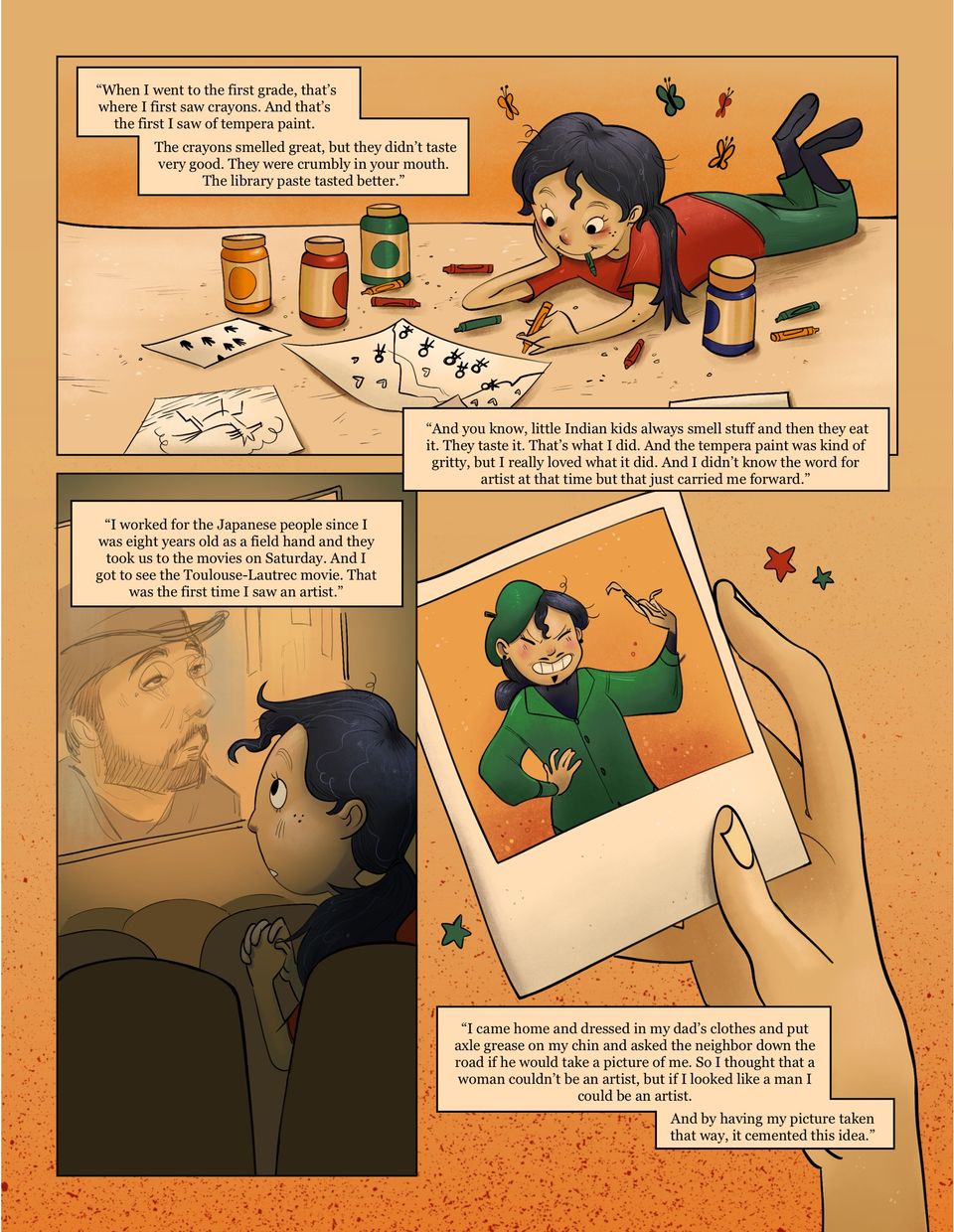
The page breaks into three panels, a large horizontal panel at the top with two vertical panels beneath it.
Panel 1:
A text box at the top of the panel reads: “When I went to the first grade, that’s where I first saw crayons. And that’s the first I saw Tempera paint. The crayons smelled great, but they didn’t taste very good. They were crumbly in your mouth. The library paste tasted better.” To the right of the text is Jaune as a child, lying on her stomach with her feet in the air. She wears a red shirt, green pants, and black socks, and holds a yellow crayon in her left hand and rests her head on her right hand. Her long brown wavy hair is pulled back in a loose ponytail and tendrils escape the ponytail frame her face. Jaune has a green crayon in her mouth and smiles at her drawings on the ground in front of her. Above her are small, colorful butterflies in red, yellow, and green. Around her on the floor are bottles of tempera paint in the colors yellow, red, green, and blue. A text box is below her contains a quote from Jaune that reads, “And you know, little Indian kids always smell stuff and then they eat it. They taste it. That’s what I did. And the tempera paint was kind of gritty, but I really loved what it did. And I didn’t know the word for artist at that time, but that just carried me forward.”
Panel 2:
Text at the top of the panel reads, “I worked for the Japanese people since I was eight years old as a field hand, and they took us to the movies on Saturday. And I got to see the Toulouse-Lautrec movie. That was the first time I saw an artist”.
Young Jaune is sitting looking at a movie screen in a theater. She watches the movie screen intently with her hands clasped together tightly and her brown eyes wide. On the movie screen is a bearded man with medium light skin wearing a gray hat and thin-framed glasses with a bored, quiet expression on his face
Panel 3:
A close up of Jaune’s hand holding a photograph of herself. In the photo, she stands with one hand on her hip and her other hand gestures with a paintbrush. She smiles cheekily with her eyes closed. Jaune is dressed in a costume; a black turtleneck with a green button-up shirt topped with a green beret on her head. She’s also drawn on a small fake mustache and goatee The text at the bottom reads: “I came home and dressed in my dad’s clothes and put axle grease on my chin and asked the neighbor down the road if he would take a picture of me. So I thought that a woman couldn’t be an artist, but if I looked like a man, I could be an artist. And by having my picture taken that way, it cemented this idea.”

The third page is divided into three horizontal panels; top, middle, and a large spacious panel at the bottom.
Panel 1:
The text box at the top reads: “When I was about 16, I sent away for the “Famous Artist Course.” My dad let me use some of my field-hand money for that. And it was all men in the pictures.”
The illustration depicts Jaune in a green button-up artist smock and a coordinating green beret. Her hair is tied back in a low bun, a single curl falls across her forehead, between her eyes. She stands with her arm to the side, surrounded by a crowd of people, some wearing the same green beret as her. The group is drawn simplistically, only showing their mouths. Some group members are smiling, while others frown or remain expressionless. Jaune pops out from the rest but looks disappointed by the lack of other women in the room.
Panel 2:
The top of Jaune’s face peeks above the edge of the panel, from the eyes up. She’s wearing her green beret and looking at a silhouetted figure to the right. Her eyebrows are furrowed; a speech bubble on the left depicts a scribble, showing her annoyance. The figure points at Jaune assertively. The text box at the top left says, “In high school, I decided that yes, I did want to go to college and take art. At the end of the year, the professor called me into his office and said.” The quote continues as a speech bubble uttered by the silhouetted figure to her right. Text bubbles read, “‘You can draw better than the men, but I have to tell you, you need to go into another field because,’ he said, ‘you’ll never be an artist. Women are not artists.’”
Panel 3:
The final panel is large and takes up the bottom half of the page. Jaune is wearing a red shirt and she sits at a table with her shoulders hunched over. Her hair is in waves around her head, tendrils curling around her face and sticking out around her head. She sticks her tongue out while she concentrates on a new drawing; a pencil presses against her cheek while she thinks. Scattered around her are stacks of paper and books. She also has a yellow cup with paintbrushes and bottles of tempera paint. A few loose papers and a box of crayons rest on her desk. In the background are sheets from a calendar flying as if blown by a strong wind, each page with a different month labeled on it. A small text box at the bottom reads, “But I did. Because of poverty and raising my children, it took me 20 years to get a BA degree.”
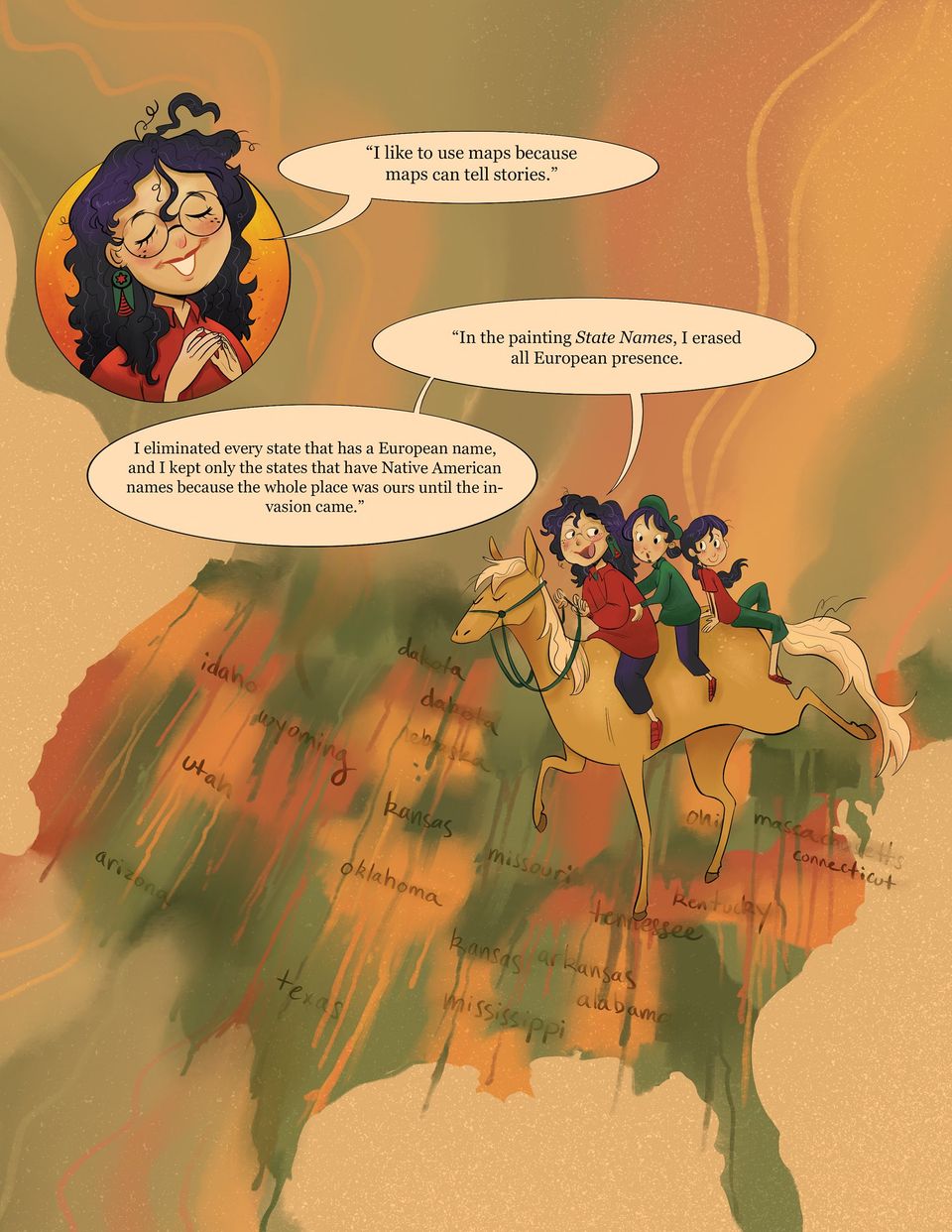
In a small, circular panel, adult Jaune speaks about her work. The background is a saturated yellow that fades to orange. Her eyes are closed while she talks, and she presses her fingertips together. Jaune says, “I like to use maps because maps can tell stories.” Below, her painting State Names bleeds out of the comic’s page. Only a few of the United States’ state names are present. Over the painting, Jaune rides a caramel-colored horse with her younger self. 16-year-old Jaune holds onto her adult self, looking astonished. 8-year-old Jaune sits at the horse's rear, playfully listening. Jaune continues her quote, “In the painting State Names, I erased all European presence. I eliminated every state that has a European name, and I kept only the states that have Native American names because the whole place was ours until the invasion came.” Some states on the map include Texas, Arizona, Oklahoma, and Mississippi.
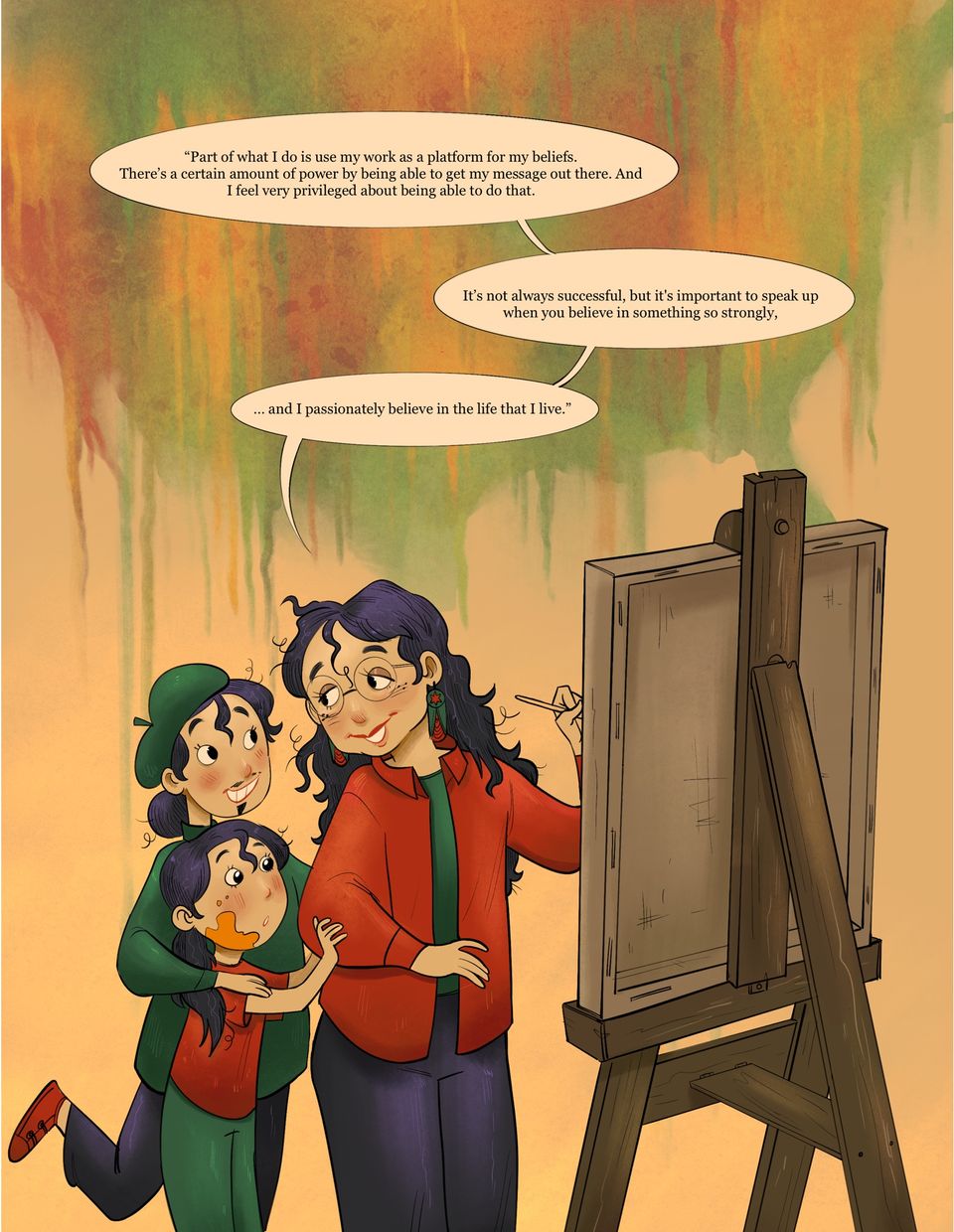
The illustration fills the entire page.
The text breaks into three connecting speech bubbles. It reads: “Part of what I do is use my work as a platform for my beliefs. There’s a certain amount of power in being able to get my message out there. And I feel very privileged about being able to do that. It’s not always successful, but it’s important to speak up when you believe in something so strongly… and I passionately believe in the life that I live.”
Jaune stands at the center, painting on an easel. Her hair is loose around her face, curling past her shoulders. She is wearing round wire-rimmed glasses, the green and read earrings she wore on the cover, a red jacket with a green shirt underneath, and blue pants. She looks to her right, over her shoulder, speaking to versions of her younger self; her 16-year-old self wearing the green beret and green buttoned-up coat and grease paint facial hair, and her 8-year-old self, who has orange tempera paint smeared on her face. The current Jaune looks at her younger self with love, while the 16-year-old Jaune excitedly smiles while she stands on one leg playfully. 8-year-old Jaune looks inspired as she watches her older self paint onto the canvas. In the background is a faded, colorful map of the U.S. dripping with paint. This illustration is a reference to Jaune’s painting in the Smithsonian American Art Museums collection titled State Names.

A large bottle of red tempera paint, a horseshoe, a tall daisy with a red butterfly perched on it, and another daisy lying flat on a patch of grass. Each of these items symbolizes an integral part of Jaune’s life. The text at the bottom reads “Illustrated by: Maddy Williams-Solberg.”














